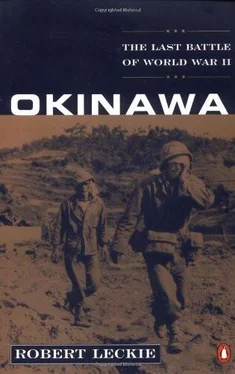By four in the afternoon, the men led by Ford reached a point opposite the north slope of Kakazu West, and were soon joined by Mitchell’s GIs moving rapidly under billowing smoke skillfully called down by Captain Hoss himself.
The Kakazu attack had failed, but it had not been a disaster. In all, Colonel May’s 383rd Regiment had suffered 326 casualties, with 23 dead, 47 missing and presumed dead, plus 256 wounded. Colonel Hara’s command may have lost half of its strength of 1,200; and for the defenders to lose nearly twice as many as the attackers, while fighting from a most formidable fixed position, testifies to the valor and skill of the American infantry.
Even before the failure at Kakazu became known at Ninety-sixth Division headquarters, Brigadier Claudius Easley, assistant commander of the Ninety-sixth, had prepared a second much more massive assault under his personal command. This “powerhouse attack” with no attempt at surprise was to be spearheaded by four battalions of infantry—about three thousand soldiers—supported by eight battalions of 105 and 155 mm artillery, together with air strikes and bombardment from the sea led by the battleship New York. There would be no tanks once again, for that gorge below the ridge was still impassable.
At 7:15 A.M. on April 10 the assault began. Furious as the preliminary bombardment had been, it in no way depleted Ushijima’s troop strength. When the bombardment lifted, his men—safe and invisible within his steel-and-coral fortress—would reply with small arms, machine guns, mortars, and occasionally one of those huge 624-pound mortar shells. Once again the Ninety-sixth fought gallantly, but flesh-and-blood advancing in the open, no matter how valiantly, simply cannot overcome an unseen enemy firing from within underground fortifications of steel and coral. It was almost as though the Japanese and the Americans had exchanged battle doctrines: the defenders relying upon firepower and the invaders on spiritual power, with the inevitable consequence: The Americans were stopped. Fortunately for them, a heavy rain—the forerunner of drenching downpours soon to come—squelched the battle, or their casualties might have been greater.
It required two more days of hideous combat to convince General Easley that Kakazu was simply too formidable for the Ninety-sixth to conquer alone. On April 11 Colonel John Cassidy’s battalion of the 381st Regiment made its second attempt to seize the top of the ridge and was again driven back. That night the Japanese began bombarding the Americans pinned down in the gorge with their 320 mm spigot mortars. One of these huge projectiles, woefully inaccurate and fired so haphazardly, seemingly did strike harmlessly on the ground—but with enough force to start a landslide that buried a cave being used as an aid station, killing thirteen Americans and wounding nine.
On the morning of the twelfth, Easley ordered another attack by Cassidy’s battalion, supported by heavy air strikes. When the Ninety-sixth moved out, there fell upon them a shower of mortar shells so thick that they came down at the rate of better than sixty a minute. Forty-five men were lost, and that was the end of the Kakazu debacle of April 9-12.
During the failed April 9-12 assaults the only appreciable gains made by the Twenty-fourth Corps was by the veteran Seventh Infantry Division on the left or eastern flank of the Ninety-sixth. From Triangulation Hill to Ouki on Nakagusuku Bay, the Seventh drove forward one thousand yards. Ouki fell to the Thirty-second Infantry on April 11, but the Americans were promptly evicted. By the night of April 12 all of the Seventh’s formations were halted in front of Hill 178, a towering crag in roughly the center-east of Ushijima’s line, which was also a Japanese artillery observation point. Farther east the Ninety-sixth’s 382nd Regiment had been stopped cold at Tombstone Ridge, where on April 11 it went into defensive positions. Tombstone may have been every bit as tough as Kakazu, but no assault was planned until General Hodge and his division commanders could assess the situation.
Casualties in the Seventh and Ninety-sixth divisions had been 451 dead, with 241 missing and presumed dead and 2,198 wounded, for a total of 2,890. Enemy losses were estimated at 5,750—all killed—although this was almost certainly exaggerated. A truer figure more likely would be about 4,000. Most of these men were killed by bombardment, for during April 9-12 the American invaders had hurled a massive weight of metal from land, sea, and air upon the defending Japanese. The fact that Kakazu, Tombstone, and Ouki remained in enemy hands demonstrated to the American commanders that the key to success on Okinawa lay in possession of the reverse slopes of all those ridges from Kakazu to Shuri Castle. Seizing the forward slopes, though difficult, could be done—but any attempt to drive past them would bring upon the attackers that dreadful rain of enemy fire.
What was needed, it seemed to General Hodge, was even heavier bombardments—and there was not yet enough ammunition ashore. The loss of those two ammunition ships to the kamikaze, deemed not critical at first, was now one of the chief causes of delay. Kakazu would have to wait until enough 105 and 155 mm shells had come across the beaches to make sustained daily shelling a reality. Already, after only about nine days of battle, it had become apparent that the Okinawa campaign would depend upon supply as much as battle.
Back to Banzai!
CHAPTER TWELVE
Reports of the Battle of Kakazu Ridge were received by Lieutenant General Isamu Cho (he had received another star) and Colonel Hiromichi Yahara with predictable reactions. Although neither knew the exact number of enemy fallen or even their own losses, Yahara was eminently pleased with the result. The Americans had been dealt a bloody repulse exactly as he had planned in his defense-in-depth tactics, and soon the rate of attrition among them would so whittle the Tenth Army that the Americans would cancel their offensive so that not only the homeland would be saved, but Okinawa as well.
To General Cho it appeared that the enemy had suffered grievously and was so rocked back on their heels that the time had come for a full-scale offensive of the Thirty-second Army. Since his humiliation in the earlier showdown between him and Yahara, when General Ushijima had sided with his planning chief, the fiery Cho had not ceased to press for a counter-attack. But even his friend and mentor Ushijima remained unmoved, until an order from Imperial Headquarters was received urging the Thirty-second Army to overrun Yontan and Kadena Airfields. This was probably the result of a Japanese intelligence warning that Marine Corsairs would soon arrive at these airfields in strength and would make the mission of the various kikusui more difficult than ever. Cho seized on this directive to persuade Ushijima on April 6 to order an attack prepared for April 8. But the ever-alert Yahara pounced upon the appearance of a 110-ship convoy offshore of the Urasoe-Mura Escarpment on April 7 as proof that the Americans were going to strike the Sixty-second Division on its flank. Alarmed, Ushijima for the second time canceled a Cho-sponsored assault.
But then both the American failure at Kakazu Ridge and the “remarkable” destruction wrought upon the enemy fleet by the first of the kikusui convinced Ushijima and Cho that the time to strike had indeed come. This misconception was strengthened by “a stirring telegraph order” from Naval Headquarters claiming that Ten-Go had been “very successful.” “There are signs of uneasiness among enemy forces and odds are seven to three in our favor.” Everyone involved in the Okinawa defense should unite in “a general pursuit operation.”
Читать дальше










